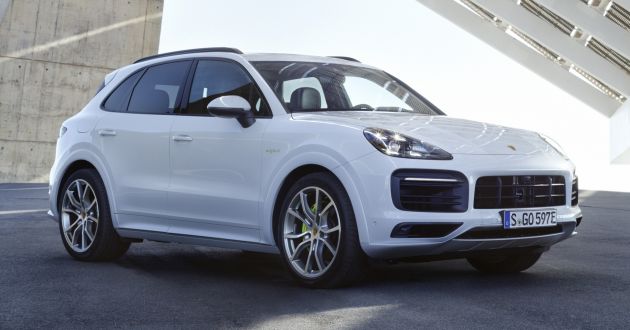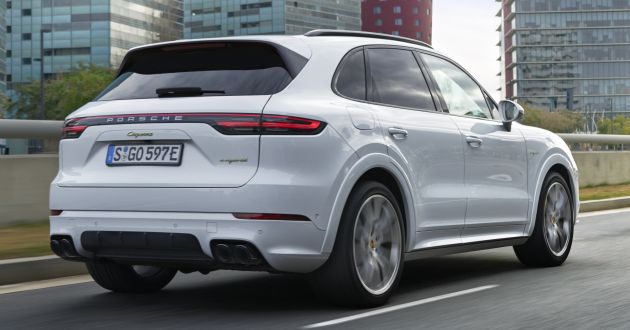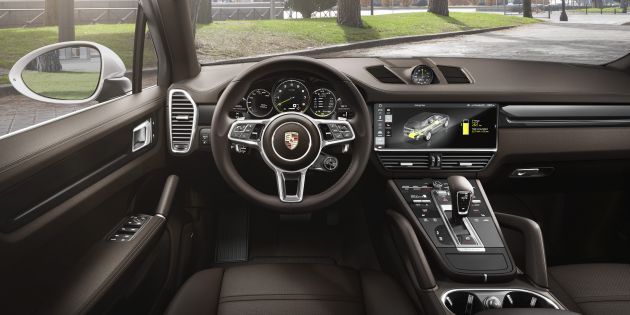The E3 Porsche Cayenne E-Hybrid is the latest addition to the German carmaker’s SUV line-up, and it joins existing variants like the base Cayenne, Cayenne S and Cayenne Turbo. The plug-in hybrid Cayenne will go on sale in Europe in late May this year, with prices starting from 89,822 euros (RM422,871).
The Cayenne E-Hybrid features a 3.0 litre turbocharged V6 petrol engine (340 PS) that improves on its predecessor by 7 PS. The electric motor (136 PS) is also 43% more powerful than before, contributing to a total system output of 462 PS and 700 Nm. As a side note, this setup is similar to that used in the Bentley Bentayga Hybrid, although the performance figures differ. Also, the outputs are similar to the Panamera 4 E-Hybrid despite the sedan using a smaller 2.9 litre turbo V6.
These figures eclipse those of the second-generation model (E2), which only has 416 PS and 590 Nm. It also enables the Cayenne to accelerate from a standstill to a top speed of 253 km/h, with the first hundred being met in just five seconds.
The hybrid module, with its combination of electric engine and separating clutch, now uses the previous an electromechanically-operated clutch rather than the previous electro-hydraulic system with a spindle actuator. This allows for faster reaction times, and works with an eight-speed Tiptronic S automatic transmission.
Also included is a boost strategy derived from the 918 Spyder, which ensures the electric motor can be used in all the standard Sport Chrono Package’s driving modes for an additional performance boost.
Porsche claims the PHEV offers a driving distance of up to 44 km in electric-only mode, and will consume as little as 3.2 litres of fuel per 100 km following the New European Drive Cycle (NEDC). It will also reach an electric-only top speed of 135 km/h.
Supporting these capabilities is a liquid-cooled lithium-ion battery placed underneath the loading floor in the boot. Consisting of eight cell modules with 13 prismatic lithium ion cells each, the battery has a capacity of 14.1 kWh, which is a 30% increase from the 10.8 kWh unit before. It’s also the same capacity as what you’ll find in the Panamera 4 E-Hybrid.
When the vehicle is plugged into a 3.6 kW charger (230 V, 10 A connection), the battery is charged within 7.8 hours. Alternatively, with the optional 7.2 kW on-board charger and a 230 V, 32 A connection, the recharge time is shortened to 2.3 hours.
The charging process can be managed and monitored via Porsche Communication Management (PCM) and remotely using the Porsche Connect app. The latter allows for climate pre-conditioning, charging station locator and cross-provider access to public charging stations.
Other drive-related bits include an active hang-on all-wheel drive with an electronically regulated, map-controlled multiplate clutch, Porsche Traction Management (PTM), Porsche Active Suspension Management (PASM) and the optional Porsche Dynamic Chassis Control (PDCC).
An expanded range of available equipment has been added as well, with a colour head-up display and Porsche InnoDrive – the latter with adaptive cruise control, massage seats, a heated windscreen, independent heating with remote operation and 22-inch wheels.
Looking to sell your car? Sell it with Carro.











Are you sure with the FC at 3.2l/100 the range is only 441km? Hmm its kind of worse that an old wira.
Gerard is right. The combined fuel economy is calculated by a total consumption of urban and extra-urban cycles over the total distance of 10932 meters (10.9km). The total test time amounts to 1180s with an average speed of 33.35 km/h. As the test cycle starts with a full battery, the battery is still nearly full after 10.9km only and therefore 3.2l/100km has nothing to do with real world conditiions. Those who designed the test cycle have to be blamed for that.
Well he changed the 441 to 44 in PHEV mode.. It was confusing as 441 seems a totally different level. Silently edited.. Hehehe.. Now 44 is more likely, but the full range on petrol & electric distance also needs to be put in
Apologies. There was a formatting error in Porsche’s press site.
As for the full range, none has been quoted. The fuel tank capacity is not known either.